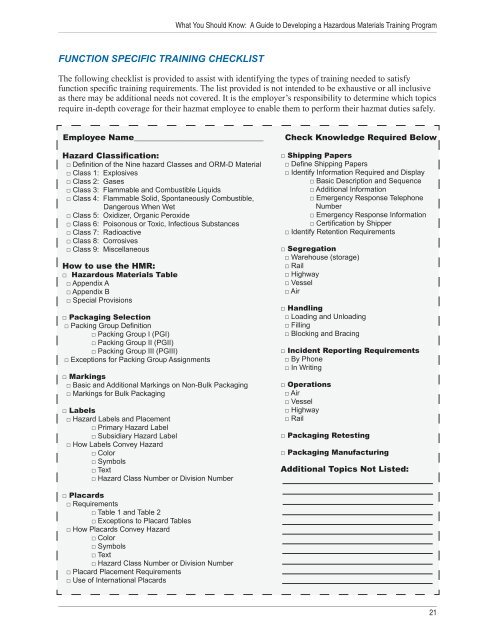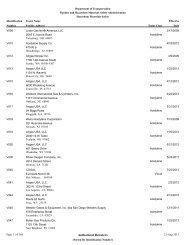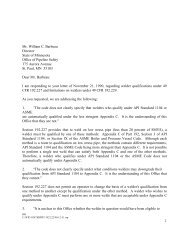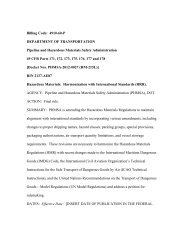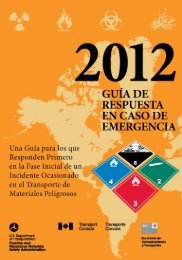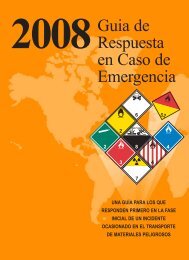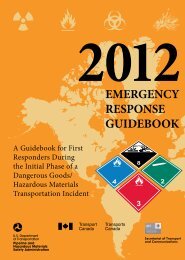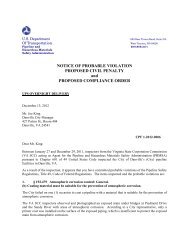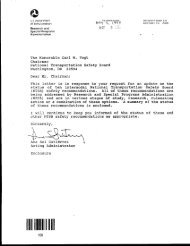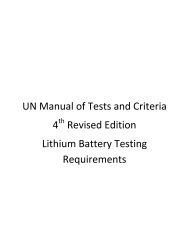Training Guidance7609am.indd - PHMSA - U.S. Department of ...
Training Guidance7609am.indd - PHMSA - U.S. Department of ...
Training Guidance7609am.indd - PHMSA - U.S. Department of ...
You also want an ePaper? Increase the reach of your titles
YUMPU automatically turns print PDFs into web optimized ePapers that Google loves.
FUNCTION SPECIFIC TRAINING CHECKLIST<br />
What You Should Know: A Guide to Developing a Hazardous Materials <strong>Training</strong> Program<br />
The following checklist is provided to assist with identifying the types <strong>of</strong> training needed to satisfy<br />
function specifi c training requirements. The list provided is not intended to be exhaustive or all inclusive<br />
as there may be additional needs not covered. It is the employer’s responsibility to determine which topics<br />
require in-depth coverage for their hazmat employee to enable them to perform their hazmat duties safely.<br />
Employee Name________________________________ Check Knowledge Required Below<br />
Hazard Classifi cation:<br />
□ Defi nition <strong>of</strong> the Nine hazard Classes and ORM-D Material<br />
□ Class 1: Explosives<br />
□ Class 2: Gases<br />
□ Class 3: Flammable and Combustible Liquids<br />
□ Class 4: Flammable Solid, Spontaneously Combustible,<br />
Dangerous When Wet<br />
□ Class 5: Oxidizer, Organic Peroxide<br />
□ Class 6: Poisonous or Toxic, Infectious Substances<br />
□ Class 7: Radioactive<br />
□ Class 8: Corrosives<br />
□ Class 9: Miscellaneous<br />
How to use the HMR:<br />
□ Hazardous Materials Table<br />
□ Appendix A<br />
□ Appendix B<br />
□ Special Provisions<br />
□ Packaging Selection<br />
□ Packing Group Defi nition<br />
□ Packing Group I (PGI)<br />
□ Packing Group II (PGII)<br />
□ Packing Group III (PGIII)<br />
□ Exceptions for Packing Group Assignments<br />
□ Markings<br />
□ Basic and Additional Markings on Non-Bulk Packaging<br />
□ Markings for Bulk Packaging<br />
□ Labels<br />
□ Hazard Labels and Placement<br />
□ Primary Hazard Label<br />
□ Subsidiary Hazard Label<br />
□ How Labels Convey Hazard<br />
□ Color<br />
□ Symbols<br />
□ Text<br />
□ Hazard Class Number or Division Number<br />
□ Placards<br />
□ Requirements<br />
□ Table 1 and Table 2<br />
□ Exceptions to Placard Tables<br />
□ How Placards Convey Hazard<br />
□ Color<br />
□ Symbols<br />
□ Text<br />
□ Hazard Class Number or Division Number<br />
□ Placard Placement Requirements<br />
□ Use <strong>of</strong> International Placards<br />
□ Shipping Papers<br />
□ Defi ne Shipping Papers<br />
□ Identify Information Required and Display<br />
□ Basic Description and Sequence<br />
□ Additional Information<br />
□ Emergency Response Telephone<br />
Number<br />
□ Emergency Response Information<br />
□ Certifi cation by Shipper<br />
□ Identify Retention Requirements<br />
□ Segregation<br />
□ Warehouse (storage)<br />
□ Rail<br />
□ Highway<br />
□ Vessel<br />
□ Air<br />
□ Handling<br />
□ Loading and Unloading<br />
□ Filling<br />
□ Blocking and Bracing<br />
□ Incident Reporting Requirements<br />
□ By Phone<br />
□ In Writing<br />
□ Operations<br />
□ Air<br />
□ Vessel<br />
□ Highway<br />
□ Rail<br />
□ Packaging Retesting<br />
□ Packaging Manufacturing<br />
Additional Topics Not Listed:<br />
21


